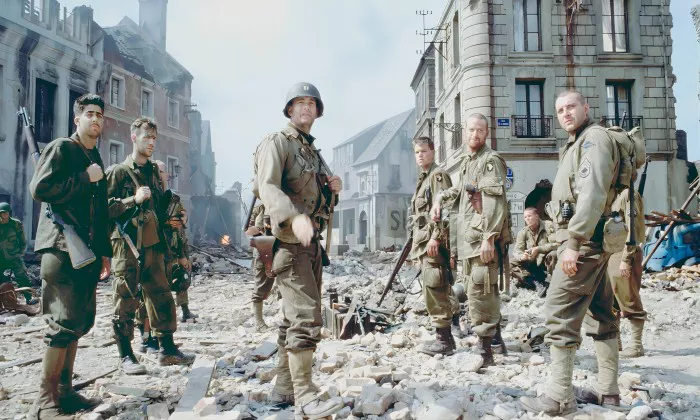In the vast landscape of cinema, certain films stand out not just for their entertainment value but also for their ability to leave a lasting impact on audiences. One such film is “Saving Private Ryan,” directed by Steven Spielberg and released in 1998. Renowned for its visceral depiction of World War II and its emotional depth, “Saving Private Ryan” has sparked discussions, debates, and admiration since its release. But what lies behind the iconic imagery and gripping narrative of this cinematic masterpiece? Let’s delve into the heart of “Saving Private Ryan” to uncover its origins, its purpose, and its enduring legacy.
Is “Saving Private Ryan” Based on a True Story?
One of the questions that often arises regarding “Saving Private Ryan” is whether it is based on a true story. While the characters and specific events portrayed in the film are fictional, the overarching premise draws inspiration from real-life events. The film’s opening sequence, depicting the harrowing Omaha Beach landing during the Normandy invasion on June 6, 1944, is particularly renowned for its realism and historical accuracy. Spielberg and his team meticulously researched the details of the D-Day landings, consulting with veterans and historical experts to ensure authenticity in their portrayal. While the characters may be fictional, the bravery and sacrifice depicted in “Saving Private Ryan” are reflective of the countless acts of heroism witnessed during World War II.
The Point of “Saving Private Ryan”
At its core, “Saving Private Ryan” grapples with profound questions of duty, sacrifice, and the human cost of war. The film follows a group of soldiers tasked with locating and bringing home Private James Francis Ryan, whose three brothers have been killed in action. As Captain John Miller and his men traverse the war-torn landscape of Normandy, they confront the harsh realities of combat and wrestle with the moral implications of their mission. Through their journey, “Saving Private Ryan” explores themes of camaraderie, loss, and the value of individual lives amidst the larger context of war.
The point of “Saving Private Ryan” is not merely to entertain but to provoke thought and reflection on the human experience in times of conflict. By placing the audience in the midst of the chaos and carnage of World War II, Spielberg invites viewers to confront the brutality of war and to consider the sacrifices made by those who served. In doing so, the film pays homage to the courage and resilience of the soldiers who fought and died for their countries while also acknowledging the toll that war takes on the human spirit.
What Makes “Saving Private Ryan” So Good?
Several factors contribute to the enduring greatness of “Saving Private Ryan.” Firstly, Spielberg’s masterful direction and innovative filmmaking techniques set the film apart. The opening sequence, with its visceral depiction of the Omaha Beach landing, is often hailed as one of the most realistic portrayals of combat ever captured on film. Spielberg’s use of handheld cameras, desaturated colors, and immersive sound design plunges viewers into the heart of battle, evoking a sense of urgency and intensity that is both gripping and unforgettable.
Moreover, the performances of the cast, led by Tom Hanks as Captain Miller, add depth and humanity to the characters. Hanks brings a quiet strength and vulnerability to his role, embodying the moral conscience of the film as he grapples with the weight of his decisions. Supported by a talented ensemble cast, including Matt Damon, Tom Sizemore, and Vin Diesel, Hanks delivers a performance that resonates on both emotional and intellectual levels.
Additionally, the screenplay by Robert Rodat strikes a delicate balance between action-packed drama and introspective reflection. Rodat’s script captures the camaraderie and banter of soldiers in wartime while also delving into deeper themes of morality and sacrifice. The dialogue feels authentic and poignant, lending credibility to the characters and their experiences.
Furthermore, the technical craftsmanship of “Saving Private Ryan” is exemplary, from Janusz Kamiński’s stunning cinematography to Michael Kahn’s precise editing. Every frame of the film is meticulously crafted, contributing to its immersive atmosphere and emotional impact. The combination of these elements results in a cinematic experience that is both powerful and thought-provoking, leaving a profound impression on audiences long after the credits roll.
Is it Worth Watching “Saving Private Ryan”?
In conclusion, “Saving Private Ryan” is more than just a film—it is an experience. Its harrowing portrayal of war, coupled with its themes of sacrifice and humanity, elevates it beyond mere entertainment to the realm of art. While the subject matter may be intense and emotionally challenging, the film ultimately rewards viewers with a deeper understanding of the human condition and the complexities of warfare. For those willing to confront the realities of history and engage with thought-provoking storytelling, “Saving Private Ryan” is undoubtedly worth watching. It is a testament to the power of cinema to educate, inspire, and provoke meaningful discourse, ensuring its place in the pantheon of cinematic classics for generations to come.
Related Topics:
Why do they call Maximus Spaniard?
Is “Gladiator” based on a true story?
Battle of Los Angeles: A Thrilling Sci-Fi Action Spectacle

